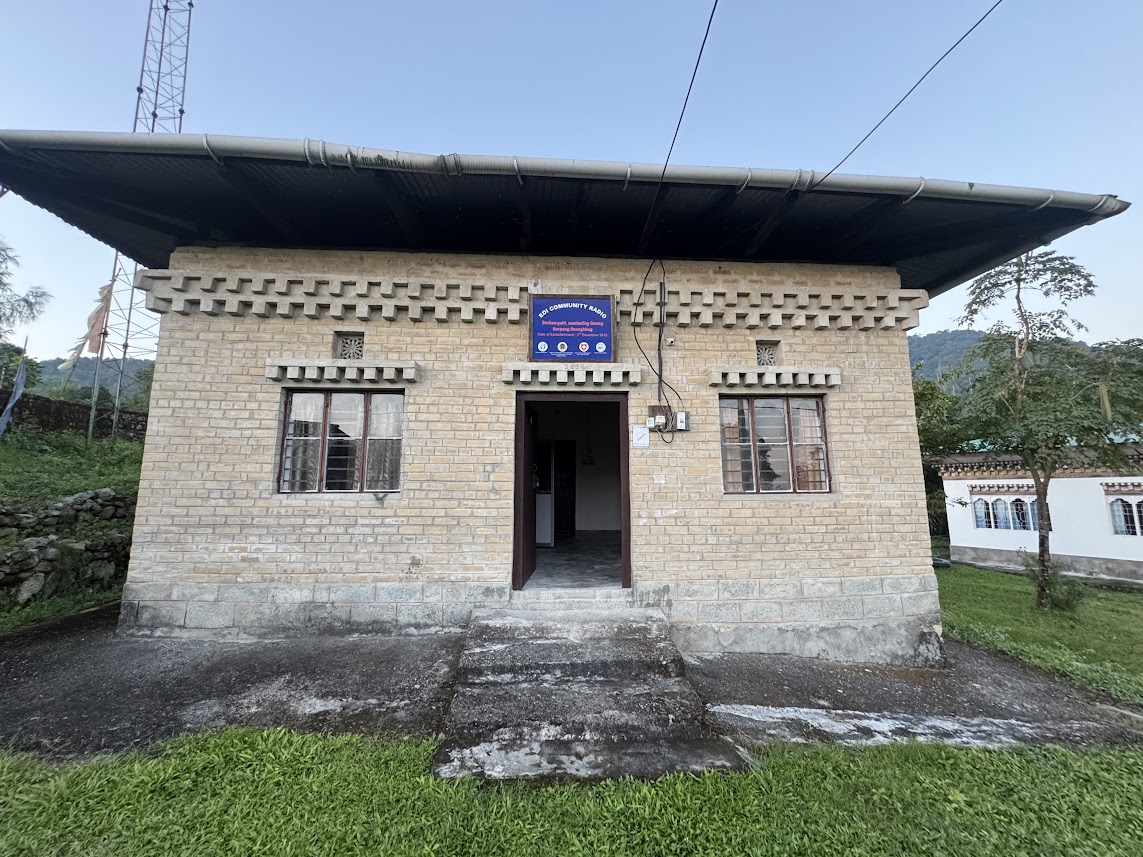Lhakpa Quendren
Gelephu—“Changma Phala Gugu. Jichu Tshula Gugu. Guna Nyamchey Gusho. Magu Rangrang Soso.” These phrases resonate in the memory of 70-year-old Namgay Wangmo, who took part in a friendly tsangmo programme at Edi Community Radio with her aunt in 2021.
During the pandemic, locals turned to community radio as a vital source of information about Covid-19, safety protocols, news, and entertainment, broadcasting nearly eight hours daily. Namgay Wangmo, a regular listener, tuned into Edi Community Radio FM 91.01 MHz every day for astrology updates (Zakar) and various programmes. However, she has not listened to the radio for the past three years due to a malfunction, and she noted: “I heard the radio is no longer available in the market.”
In Dechenpelri (Edi) of Samtenling Gewog, Sarpang, nearly every household seems to have turned away from Edi Community Radio, which resulted in sporadic broadcasts in the post-pandemic period. The radio remains suspended during the summer due to the dangers of lightning in the south, while inconsistent programming in winter—despite the lack of audience—raises concerns about its sustainability.
This raises the question: Is the radio becoming irrelevant as fewer people listen to it? Dechenpelri Tshogpa Karma Tenzin acknowledges that radio is no longer the dominant medium in his community. He observes that the rise of social media platforms such as WeChat, Telegram, WhatsApp, Facebook, and TikTok poses a major threat to traditional radio. “People today have different options for news and music.”
“At first, locals participated in various programmes, including important announcements from the gewog administration. Now, WeChat has become the most popular social platform in my community, and all communications happen through it,” said Karma Tenzin.
Initially, language barriers led locals to prefer community radio, which aired programmes in their primary local dialects, such as Tshangla, Khengkha, and Lhotsamkha, alongside Dzongkha and English. However, as many community members have gained proficiency in Dzongkha through non-formal education, many have since switched to television.
Is radio, as we know it, fading away? Despite competition from digital media, some people still include radio in their media consumption—often listening while driving or tuning in to their favorite programs on BBS radio.
Seldon, a listener of BBS radio for news and music, believes that elderly people still rely on radio. “Although radio is not as popular now as it was when I was growing up, it still provides access to news and entertainment for those who cannot read.”
The radio and challenges
Community radio faces numerous challenges, including a lack of funding, spare parts, soundproofing systems, internet access, and training opportunities. These issues compromise content quality and hinder efforts to attract and retain an audience in an increasingly crowded digital landscape.
Fifty-eight-year-old Jambay Tshering has volunteered as a manager and programme producer for the past nine years, but he now struggles to maintain an active role in community radio. While digital media continue to rise in popularity, Jambay believes that traditional FM radio can still retain listeners if young people are encouraged to engage in community programming.
“For that, we need funding for skill training on various topics, as young people are not showing interest otherwise,” he said, adding that capacity building is another hurdle for sustainability. “Funds for transportation, utility payments, and other miscellaneous needs should also be considered.”
Jambay emphasised that Edi Community Radio is a vital tool for preserving and promoting local culture, traditions, languages, ancient songs, and stories. “Many cultural elements are at risk of vanishing, with some already extinct.”
The community radio serves as a platform for discussing development activities and raising awareness about disasters, among other topics, in collaboration with officials and local government leaders. These discussions are scheduled from 7pm to 11pm, based on listener preferences.
Edi Community Radio can reach over 2,850 listeners within a seven-kilometre radius, covering areas such as Dechenpelri, Samtenthang, Zomlingthang, Pemathang, Lekithang, Pelrithang, and Gelephu town. The signal extends to Serzhong, Chhuzagang, and Umling, thanks to the flat terrain.

Established by the Tarayana Foundation in 2015, Edi Community Radio was initially created for 41 households that relocated to Sarpang from the military-affected Edi village in Zhemgang during the 2003 insurgency. The community has since grown to over 100 households, totaling about 800 residents. While the foundation initially distributed 75 radios, nearly every household no longer possesses one today.
The other two community radios—Lhop Community Radio in Dophuchen, Samtse, and Khotakpa Youth Development Radio in Pemagatshel—have been off the air since 2019 due to technical issues and funding shortages exacerbated by the pandemic. These community radios were established between 2014 and 2015 in collaboration with the former Ministry of Information and Communication, with support from UNESCO’s International Program for the Development of Communication and HELVETAS (Swiss Inter-Co-operation).


